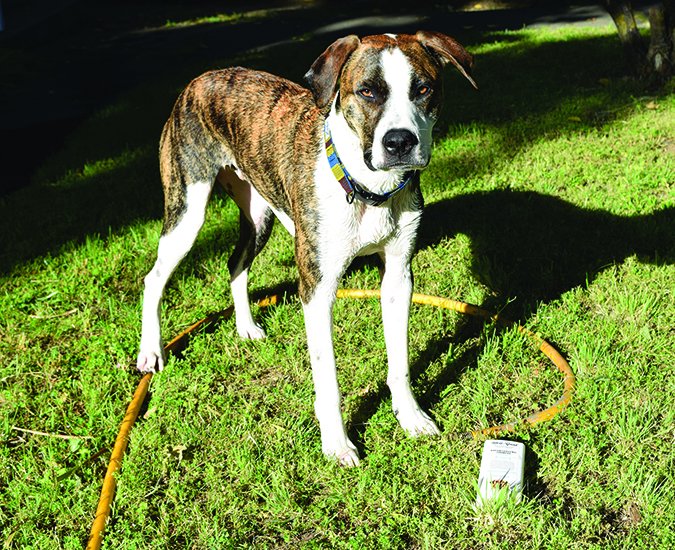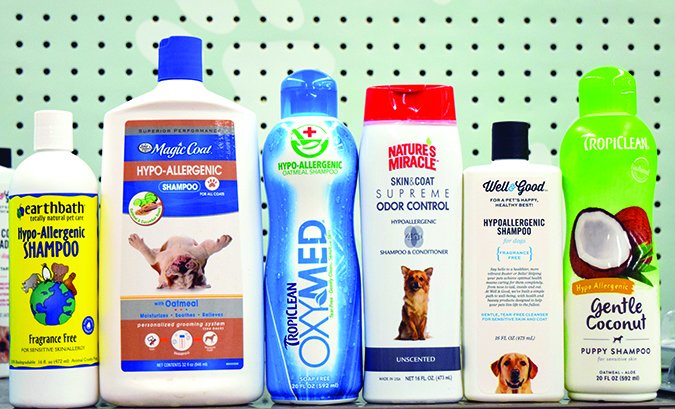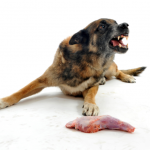The appellation “hypoallergenic” is a misnomer, but alert owners of dogs with sensitive skin can find products that are safer and gentler than regular dog shampoos.
By Cynthia Foley is a a freelance writer and dog-agility competitor in New York.
With literally hundreds of dog shampoos on the market, it can be difficult to decide which one is best for your dog. Many of us overly cautious dog owners correctly want to avoid dyes, fragrances, and chemicals, knowing these ingredients can irritate our dog’s skin – and possible adversely affect his health. We believe a shampoo with the word “hypoallergenic” in its name should be safer and better for our dog’s overall health.
The problem is, there is no legal definition of the term “hypoallergenic” (see below).
If you asked any adult for a common definiThe phrase “hypoallergenic” was first used in advertising by the cosmetics company Almay in 1953. Almay was founded in 1931 by Alfred and Fanny May Woititz when Alfred, a chemist, began developing skin care products for his wife – cosmetics that wouldn’t irritate Fanny May’s sensitive skin. Almay was the first company to market the concept of skincare product safety, and set itself apart by producing fragrance-free products, including all product ingredients on product labels, and testing its products for allergy and irritation. After its introduction by Almay, the description “hypoallergenic” quickly became widespread in the cosmetics industry – even if the products they described were not, in actual fact, less allergenic than other products.
The Food and Drug Administration (FDA) regulates the cosmetic industry in the United States. The FDA provides guidance and enforcement for cosmetic companies in order to ensure the safety of consumers. It also provides oversight of labels and misrepresentations under the Food, Drug, and Cosmetic Act and the Fair Packaging and Labeling Act. These Acts provide definitions for anything that can be on a cosmetic product label. “Shampoo,” not incidentally, is defined as a cosmetic: “articles intended to be rubbed, poured, sprinkled, or sprayed on, introduced into, or otherwise applied to the human body . . . for cleansing, beautifying, promoting attractiveness, or altering the appearance… .”
In 1974, the FDA attempted to regulate the phrase hypoallergenic as it pertains to cosmetics. It proposed that a product should be permitted to be labeled hypoallergenic only if scientific studies on human subjects showed the product caused a significantly lower rate of adverse skin reactions than ordinary products.
Comments on the proposal were received from consumers, consumer advocacy groups, and cosmetic manufacturers. The FDA issued its final regulation in 1975 – and two cosmetic companies, Almay and Clinique (another company specializing in “hypoallergenic” products), immediately filed suit to have the regulation ruled as invalid. Eventually, the U.S. Court of Appeals agreed with their objections, stating that the FDA had not demonstrated that consumers perceive the term “hypoallergenic” in the way described in the regulation.
The FDA has not attempted to codify regulations regarding hypoallergenic products since. A 1978 FDA consumer magazine article about the battles over the “hypoallergenic” regulations concluded, “As a result of the decision, manufacturers may continue to label and advertise their cosmetics as ‘hypoallergenic’ or make similar claims without any supporting evidence. Consumers will have no assurance that such claims are valid.”
What about hypoallergenic dog shampoos? Well, it’s even less charted territory. We’ve already established that hypoallergenic lacks a legal definition. Dog shampoos that claim to cure, treat, or otherwise mitigate a disease or ailment are regulated by the FDA’s Center for Veterinary Medicine. Dog shampoos that claim to kill or control fleas or ticks fall under the regulatory purview of the Environmental Protection Agency. But “regular” dog shampoos, “hypoallergenic” or otherwise, fall under the category of “grooming aids,” which are not regulated by any governmental or non-governmental agency in this country.
“Hypoallergenic” is the Best Label We’ve Got
Despite the lack of a legal or even accurate definition of the phrase “hypoallergenic shampoo,” manufacturers that use that phrase are generally trying to identify products that are formulated without ingredients that commonly cause adverse reactions in sensitive dogs. Given the lack of a legal description, we, too, are forced to use the appellation to discuss the type of product we’d recommend for dogs with super-sensitive skin. For the rest of the article, we’re going to grit our teeth and refrain from using quotation marks around the phrase hypoallergenic shampoo, and trust that you understand.
Just keep in mind that while these products might reduce the potential for harming a chemically sensitive or allergy-prone dog, there are no guarantees that this will be the case for any specific dog. And there are no regulators – only your own informed diligence – making sure that a product marketed as hypoallergenic has any fewer ingredients or less-harmful ingredients than any other ordinary shampoo.
Why is My Dog’s Skin So Sensitive?
If your dog seems chronically itchy, or always seems to have red, irritated skin and/or excessive dander, make an appointment with your veterinarian.tion (rather than a legal definition) of hypoallergenic, most would likely guess that it means a product without allergens in it – even though this is impossible. Every substance, including water, can cause an allergic reaction in someone, somewhere. The prefix hypo actually means “beneath” or “below.” Medical dictionaries do the best job of defining the phrase as “having diminished (our emphasis) potential for causing an allergic reaction.” In this instance, then, the word should be taken to identify a product that contains fewer potentially allergenic substances than other products on the market.
We have issues with the latter part of the word, too. Technically speaking, an allergen is any substance that causes an allergic response – one that sets off a hypersensitive immune response, ranging from localized inflammation to a fatal, systemic anaphylaxis. We’d submit that it probably is quite rare for a dog to suffer a true allergic reaction to an ingredient in a shampoo; it’s far more likely for a dog to suffer simple (if serious) contact dermatitis.
A dog with contact dermatitis from an ingredient or ingredients in his shampoo will likely have an immediate adverse response that’s based on where the ingredients came into contact with his skin, the strength of the solution, and how long it was left on his skin.
In contrast, a dog with an allergic reaction may not exhibit signs of trouble the first time he comes in contact with the allergenic substance; however, subsequent exposures may bring about more rapid and widespread reactions. He may exhibit skin irritation all over his body, even when exposed to the problematic allergen in a very small amount or for a very short period.
For all these reasons, we don’t like the phrase hypoallergenic shampoo!
What is a “Hypoallergenic” Dog Shampoo – and Who Regulates It?
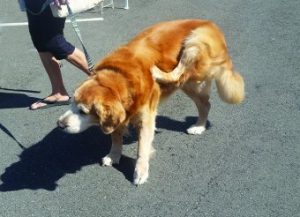
The problem might just be caused by environmental allergies (to things such as pollen or dust mites) or too much sun (yes, dogs can get sunburned) – conditions that might benefit from a bath with a gentle, non-irritating shampoo.
But itchy dry skin can be caused by disease as well, including Cushing’s, hypothyroidism, bacterial/fungal infections, parasites, environmental allergies, and even cancer. Itchy skin can also be a reaction to something the dog has eaten; your dog may be allergic to something in his diet. While a bath might give the skin temporary relief, you can’t bathe away reactions to food. Alternatively, a food might offer some relief; your veterinarian may recommend a nutritional supplement, such as fish oil, to promote skin health. But without a correct diagnosis, you delay proper treatment and the problem can worsen.
Or, you might just learn that your dog has inherited a propensity for irritated skin. “Genetics plays a big role in many of the skin diseases that veterinarians deal with. Coat color has an impact in some instances, such as white dogs sunburn more easily, but in many cases it’s the breed that’s the issue; for example, we see allergies in black, yellow, or chocolate Labs,” says William H. Miller Jr., VMD, DACVD, Professor of Dermatology and Medical Director of the Companion Animal Hospital at the Cornell University College of Veterinary Medicine.
“Some blue-colored dogs will lose hair because of a defect in their coat color genetics while other blue-colored dogs have beautiful coats because they don’t have the abnormal coat color genes,” Dr. Miller says.
The bottom line? Involve your veterinarian any time a skin condition fails to improve within a week after a bath with a gentle shampoo. And certainly take a hard look at that shampoo bottle if it worsens!
Hallmarks of Hypoallergenic Shampoos
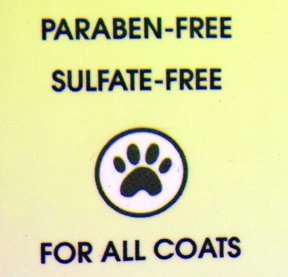
Regular shampoos are developed to cleanse your dog’s skin and coat. Shampoos generally contain at least one “surface active agent” (surfactant), a compound that lowers the surface tension between two liquids. Depending on the surfactant/s used, their activity in the product may be detergent, wetting, emulsifying, foaming, or dispersing. Shampoos may also contain thickeners (to adjust the viscosity of the product), deodorizers, fragrance, color, detanglers, and preservatives.
Products meant for dogs with sensitive skin should contain as few ingredients as possible. A shorter ingredients list means the product has fewer possible ingredients that can potentially cause a reaction.
For this reason, hypoallergenic products generally omit some of the ingredients that provide some of the traits many of us are accustomed to having in a shampoo – compounds we have come to expect in a shampooing experience, but that are unnecessary and potentially harmful to the truly super-sensitive dog. Hypoallergenic shampoos, then, generally won’t be as thick as regular shampoos, and probably won’t lather up in a nice, lush manner; they’re formulated to rinse off quickly.
Traits to Look For in Dog Shampoos
Here are the factors we weigh when shopping for a shampoo for super-sensitive dogs:
Ingredient Disclosures
The label on your dog’s food must include a complete list of ingredients, but there is no legal requirement that his shampoo, hypoallergenic or otherwise, must disclose its contents. Most shampoo labels list no ingredients at all or a generic description such as “all natural ingredients.”
In our opinion, though, the products that are marketed as particularly gentle or for dogs with particularly sensitive skin should be held to a higher standard than “regular” shampoos. Ideally, the makers of these products would list every ingredient, so that if her dog had a bad reaction to a product, a consumer could try to avoid products with those ingredients in the future – and possibly identify which ingredient caused problems for her dog.
For the most part, however, we’ve had to settle for products that list most of their ingredients and will specify which ingredients they don’t contain. That said, we consider it equally deceptive to promote a product as not containing specific unwanted ingredients but failing to state all that is in the product. If a dog has an adverse reaction to a particular shampoo, without a complete list of ingredients, the owner has no starting point for finding a replacement product.
Concise Descriptions
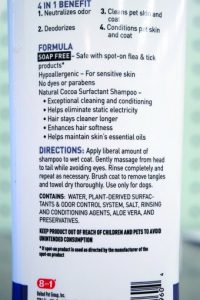
Label claims that are too vague, such as “all natural ingredients,” “proprietary,” or “herbal extracts,” get our consumer hackles up. What herbs? What plants? With generic ingredient listings like these, a consumer can’t determine if a product poses certain risks to her dog or not.
Also, the term “proprietary blend” doesn’t cut it for us. We understand that pet grooming is a competitive market, and we don’t expect a company to give away their secret formula. However, we’re not asking for the recipe. We just want to know what’s included in the finished product.
Few and Simple Ingredients
When choosing a shampoo for a sensitive dog, we look for products that cleanse our dog and rinse out easily, with a minimal number of simple ingredients. We’d avoid all unnecessary ingredients, such as perfumes, fragrances, and dyes.
Dry Skin? Avoid Sulfates
If a dog has particularly dry skin, you may wish to sacrifice suds and lather in order to avoid sulfates (including sodium lauryl sulfate, TEA lauryl sulfate, triethanalomine, and alkyl sodium sulfate) that can be irritating to dry skin.
Don’t confuse sodium lauryl sulfate with the mild detergent sodium laureth sulfate, which is widely used as a water softener and in baby and other non-irritating shampoos as a wettener and cleansing ingredient.
Long Words Are Okay in Shampoo Ingredients
Some advisors recommend that dog owners avoid products that have words that can’t easily be pronounced on the label. That’s ridiculous. I can’t say “rosmarinus officinalis,” but I know that it is rosemary, a common ingredient in hypoallergenic shampoos. Rosemary offers natural preservative capabilities as well as deodorizing, anti-inflammatory, and antiseptic properties.
Soap is Okay, Too
Of course, your own dog will have to be the judge, but in general, we’re not bothered by “soap” as an ingredient. Many hypoallergenic formulas bragged that they were “soap-free.” Soap can be chemical or natural, and it isn’t always harsh. If you see “saponified coconut oil” or “saponified olive oil” or something similar, the product contains soap. Saponification is the process by which vegetable oils or animal fats are made into soap.
The Preservative Conundrum
Preservatives are a double-edged ingredient. The chemicals that most effectively preserve shampoos are most likely to cause adverse reactions in sensitive dogs. Some examples include parabens, which might be listed on the label as propylparaben or butylparaben; these ingredients are also antibacterial. Some shampoos use formaldehyde as a preservative, which might be listed as sodium hydroxymethylhydroxymethylglycinate.
One common shampoo preservative is methylchloroisothiazolinone, developed as a replacement for formaldehyde, and popular because it’s also anti-bacterial and anti-fungal. According to Campaign for Safe Cosmetics, methylchloroisothiazolinone has been “linked to lung toxicity, allergic reactions, and possible neurotoxicity.” No, thank you, not for my dogs.
If you choose products with natural preservatives, look to see what, specifically, is the preserving agent. Is it rosemary? Is it grape seed extract? Is it lemongrass? Is it something else?
If you want to avoid preservatives altogether, buy smaller bottles of shampoo with expiration dates. And make sure that if a preservative-free shampoo includes an expiration date, don’t use the product beyond that date. It could mean that the preservative is no longer reliable after that date, so using it would totally negate the benefits of that product and, possibly, harm you or your dog.
Bathing Sensitive Dogs
If your dog has an adverse reaction to any shampoo, contact your veterinarian to see if there is anything you should do to ameliorate his symptoms. Then note the product name and its ingredients in your dog’s health journal, so you can avoid that product (and perhaps other products with similar formulations) in the future.
Keep in mind that the shampoo that you choose for your sensitive dog isn’t the only “bath factor” that can affect his skin. Bathing your dog too often can compromise the health of his skin, even with a gentle product. Excessive bathing can remove your dog’s natural oils and dry his skin and coat. Overly dry skin can crack, itch, and even bleed, setting the stage for more itching and possibly infection.
“For normal dogs, the biggest issue probably isn’t the shampoo itself but how often the bath is given and what the whole bathing protocol involves,” says William H. Miller Jr., VMD, DACVD, Professor of Dermatology and Medical Director of the Companion Animal Hospital at the Cornell University College of Veterinary Medicine. “Many people over-bathe their dogs, as far as skin health is concerned. You can cause some skin issues if you bathe your dog too often, even with a very mild shampoo.” Also, while most groomers will tell you that a dog must be completely dried after a bath in order to prevent aggravating fungal skin conditions (especially if the dog has an extremely heavy coat), Dr. Miller contends that “intense blow drying after the bath can only make things worse.”
A final note:
Don’t bathe your hypersensitive dog with a human shampoo, no matter how gentle it seems to be. Dog skin and human skin have different pH levels, with dogs being more alkaline and humans being more neutral.
